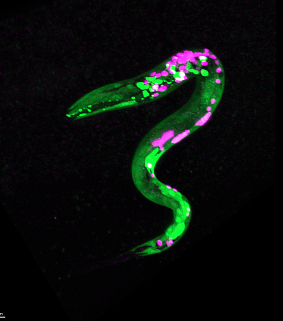EUGENE, Ore. — April 20, 2023 — If you give a worm some weed, he might just need a snack. Worms exposed to a cannabinoid became even more interested in the kind of food they already prefer, new University of Oregon research shows. The effect is analogous to a cannabis user’s craving potato chips and ice cream after a few puffs — a phenomenon scientists call “hedonic feeding,” but known more colloquially as “the munchies.”

The study, led by neuroscientist Shawn Lockery, points to worms as a useful tool for understanding more about the many roles that cannabinoids play in the body. That class of chemicals includes not only those responsible for the cannabis “high,” but many other, related compounds that occur naturally in most animals, including humans. The worm study could help researchers develop better drugs that target the human endocannabinoid system. Lockery and his team published their findings in the May 8 issue of Current Biology.
The endocannabinoid system is a far-reaching signaling network that helps regulate key body systems like appetite, mood, and pain sensation. Molecules called endocannabinoids send chemical messages by interacting with cannabinoid receptors, special proteins that are sprinkled throughout the body and brain. Normally, these messages help keep different body systems in balance. But certain compounds in cannabis, like THC, also interact with cannabinoid receptors, making users feel “high” after partaking and causing other effects, too.
When Lockery started this research, Oregon had just legalized recreational marijuana.
“So, we thought, ‘Well heck, let’s just try this!’” Lockery said. “We thought it would be amusing if it worked.”
The idea wasn’t totally out of left field. Lockery studies the neurobiology of decision-making, using a species of tiny worms called C. elegans as a simple system to test hypotheses. He often uses food choice experiments, tempting the animals with bacterial blends of varying quality to see which they prefer under different conditions. On high-quality food sources, the worms grow quickly; on lower-quality ones, they grow more slowly.
To see how cannabis-like substances might affect the worms’ food preferences, Lockery’s team soaked the worms in anandamide. Anandamide is an endocannabinoid, a molecule made by the body that activates the body’s cannabinoid receptors.
Then, they put the worms into a T-shaped maze. On one side was high-quality food; on the other side, lower-quality food. Even under normal conditions, the worms prefer the high-quality food. But when soaked in anandamide, that preference became even stronger — they flocked to the high-quality food and stayed longer than usual.
“We suggest that this increase in existing preference is analogous to eating more of the foods you would crave anyway,” Lockery said. “It’s like choosing pizza versus oatmeal.”
To humans, “high-quality” food might call to mind a nutritious spread of fruits, veggies, and whole grains. But the high-quality worm food is more like human junk food, in that it packs in a lot of calories quickly.
“The endocannabinoid system helps make sure that an animal that’s starving goes for high fat and sugar content food,” Lockery said. It’s one reason why, after consuming cannabis, users are more likely to reach for chocolate pudding than a salad.
In follow-up experiments, Lockery’s team was able to identify some of the neurons affected by anandamide. Under the influence, these neurons became more sensitive to the high-quality food, and less sensitive to the lower-quality food.
The results drive home just how old the endocannabinoid system is, evolutionarily speaking. Worms and humans last shared a common ancestor more than 600 million years ago, yet cannabinoids affect our food preferences in a similar way. “It’s a really beautiful example of what the endocannabinoid system was probably for at the beginning,” Lockery said.
The similarity in response between worms and humans also suggests that worms could be a useful model for studying the endocannabinoid system.
In particular, one current limitation with tapping into the medicinal properties of cannabinoids is their broad-ranging effects. Cannabinoid receptors are found throughout the body, so a drug targeting these receptors could help the problem at hand, but might also have lots of undesired side effects. For instance, smoking cannabis might relieve pain, but could also make it hard to focus on work.
The other nearby proteins that are also involved in the cascade of chemical messages varies, depending on the body system at play. So, better drugs could aim at these other proteins, narrowing the effects of the drug.
Worms are a good study system for picking apart these kinds of pathways, because scientists already know so much about their genetics, Lockery suggests.
“The ability to rapidly find signaling pathways in the worm could help identify better drug targets, with fewer side effects,” Lockery said.
— By Laurel Hamers, University Communications
About the College of Arts and Sciences
The College of Arts and Sciences is the University of Oregon’s largest college and the intellectual hub of the university. The College of Arts and Sciences’ liberal arts programs in the natural sciences, social sciences and humanities support the mission of the entire university and shape its identity as a comprehensive research institution. With more than 750 faculty members, the college offers more than 50 undergraduate majors, 70 minors, 42 masters’ programs, and 26 doctoral programs to more than 10,000 undergraduate students and 1,285 masters and PhD students.
Media Contact:
Molly Blancett
University Communications
blancett@uoregon.edu
541-515-5155
Source Contact:
Shawn Lockery
Professor, Biology and Neuroscience
shawn@uoregon.edu
